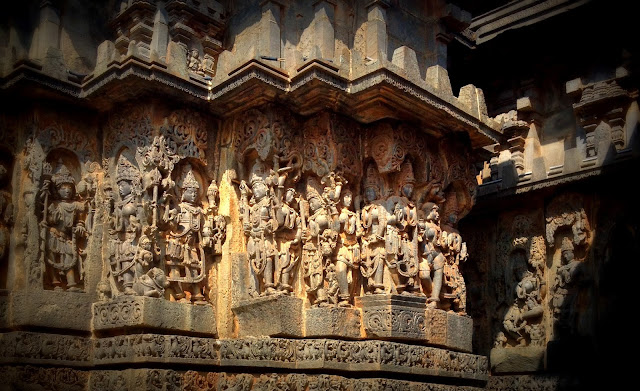Some things are too precious to be penned down, too vivid to be squeezed into sentences.
So, last week I tried to describe the beauty of Belur Temple, but words failed me. So, here I am, back at it again—attempt number two at capturing the indescribable. Let’s see if I can manage to do this stunning place some justice!
Chenna means Handsome ; Keshava means Vishnu.
In the heart of the ancient city of Belur, the temple dedicated to Lord Vishnu stands as a mesmerizing tribute to his many forms, including that of a lover. In this temple Lord Vishnu appears as an eternal lover—one who captivates the body, heart and soul with an unfathomable grace. The intricate carvings on its walls whisper tales of love and longing.
As the evening sun bathes the temple in gold, these sculptures appear to shimmer, embodying the alchemy of spirit. Each figure—arms outstretched in joy, eyes closed in profound devotion—invites visitors into a world where unadulterated expression exists beyond words. It’s as if the spiraling forms of the temple resonate with something ancient and encoded in us, spiraling through our very DNA, connecting us to a timeless rhythm of life.
In these spirals of stone, we see an echo of the cosmic dance itself, resonating with the same spiraling essence that runs through our veins.
Here, survival fades into the background, and patterns of society melt away; what remains is the raw, divine emotion, alive in every curve of these ancient figures.
Most people miss such unfiltered beauty; they’re so used to seeing through the lens of survival that true, unadulterated expression often eludes them. Perhaps it’s because they themselves are diluted, shaped by countless forces from the society over time. But here, in Belur, that unbroken strand of body, heart, and soul comes alive. Each sculpture, although carved in stone, seems to pulse with the energy of dance, an eternal homage to Lord Vishnu.
Women often perceive Lord Vishnu as the lover who truly understands their innermost desires, embodying a divine presence that offers companionship and comfort. The celestial raga known as Devagandhari beautifully captures the profound love that a woman holds for Lord Vishnu.
Devagandhari Raga is captured in the song.
https://en.wikipedia.org/wiki/Devagandhari
Another held an expression of deep devotion, as if lost in the beauty of Vishnu’s form.
To this day, these stone sculptures continue their silent, steadfast dance, dedicating every step, every emotion, and every story to Vishnu. They remind those who come to the temple that the dance of devotion is eternal, flowing through time like the river of life, forever bound to the divine.










.JPG)





Comments